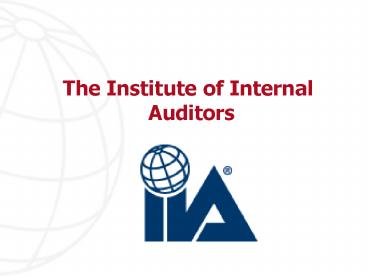The Institute of Internal Auditors - PowerPoint PPT Presentation
1 / 46
Title:
The Institute of Internal Auditors
Description:
Elevate support given Government Relations Committee ... Practice Advisories. Endorsed but not mandatory. Interpret and apply the Standards. ... – PowerPoint PPT presentation
Number of Views:103
Avg rating:3.0/5.0
Title: The Institute of Internal Auditors
1
The Institute of Internal Auditors
2
Vision
- The IIA will be the global voice of the internal
audit profession advocating its value, promoting
best practice, and providing exceptional service
to its members.
3
Mission
- To provide dynamic leadership for the global
profession of internal auditing. Activities
include - Advocacy
- Professional Development
- Research
- Education and
- Progress Through Sharing
4
Motto
- Progress Through Sharing
5
Representation
- 100,000 members
- Over 150 Countries
- 33 Institutes
- 212 Chapters
- Regional Organizations
- FLAI Federation of Latin America of Internal
Audit - ECIIA European Confederation of Internal Audit
- UFAI Union francophone de laudit interne
(Federation of French speaking institutes of
internal audit)
6
Governance Structure
7
Governance Structure
8
Governance Structure
9
Governance Structure
10
Governance Structure
11
Headquarters Structure
Effective 1/4/05
12
The IIA as a Recognized Global Authority
13
Certification
- The worldwide designation is Certified Internal
Auditor. - CIA has been in existence for over 25 years.
- 50,000 professionals are certified worldwide
14
Certification - CGAP
- The Certified Government Auditing
Professional (CGAP) - Specialty certification designed by for and
public-sector audit practitioners. - 703 public sector auditors currently hold the
CGAP
15
Professional Development
- International Conferences
- Seminars
- Educational Products
- Research
- Audit Committees
- Systems Auditability and Control (SAC)
- Competency Framework for Internal Auditing
- Governance
- Value Added Services
16
Auditing in the Public Sector
17
Addressing Government Auditors Needs
- Establish Government Auditing Resource at IIA
Headquarters - Increase government membership to 30,000 members
(from 9,000) - Government Auditingone primary focus of IIA
Advocacy Plan - Elevate support given Government Relations
Committee - Increase government auditors involvement in
volunteer leadership committees
18
Government Relations CommitteeKey Projects
- In draft The Role of Audit in Public Sector
Governance - White paper
- CollaboratorsNASACT, U.S. Comptroller Generals
Domestic Working Group - Wanted More collaborators
- Research underway Capability Maturity Model for
Government Audit
19
Government Relations CommitteeKey Projects
- International Outreach Efforts
- South Africa Initiative, lead Ontario, CA
- Developing resource bureau for training and
mentoring assistance to requesting governments
20
Resource for Government auditors
21
Public Sector Initiatives
- IFAC (International Federation of Accountants)
- OECD (Organization of Economic Cooperation and
Development)
22
Standards for the Professional Practice of
Internal Auditing
23
Professional Practices Framework
Development Practice Aids
Standards Ethics
Practice Advisories
24
Categories of Guidance
- Code of Ethics
- Attribute, Performance,
- Implementation Standards
Ethics Standards
Professional Practices Pamphlets
Practice Advisories
- Books
- Research Studies
- Seminars
- Conferences
Development Practice Aids
25
Standards
Attribute Standards address attributes of
organizations and individuals performing internal
audit services.
Performance Standards describe the nature of
internal audit services and provide quality
criteria against which the performance can be
measured.
Implementation Standards expand upon attribute
and performance standards and provide guidance
applicable to specific types of engagements.
26
Practice Advisories
- Endorsed but not mandatory.
- Interpret and apply the Standards.
- May be industry, specialty, or geographically
specific.
- May address emerging issues or cover areas
without specific Standards.
27
Development Practice Aids
- Developed and/or endorsed by The IIA.
- Includes
- Research Reports
- Books and Other Publications
- Seminars
- Conferences
28
Definition of Internal Auditing
Internal auditing is an independent, objective
assurance and consulting activity designed to add
value and improve an organization's operations.
It helps an organization accomplish its
objectives by bringing a systematic, disciplined
approach to evaluate and improve the
effectiveness of risk management, control, and
governance processes.
29
Code of Ethics
- Principles
- Rules of Conduct
30
Code of ConductPrinciples
- Integrity
- Objectivity
- Confidentiality
- Competency
31
Code of ConductPrinciples
- Integrity
- Objectivity
- Confidentiality
- Competency
32
Standards
- Attribute Standards
- Performance Standards
- Implementation Standards
33
Attribute Standards
- Purpose, Authority, and Responsibility
- Independence and Objectivity
- Organizational Independence
- Individual Objectivity
- Impairments to Independence or Objectivity
34
Attribute Standards
- Purpose, Authority, and Responsibility
- Independence and Objectivity
- Organizational Independence
- Individual Objectivity
- Impairments to Independence or Objectivity
35
Attribute Standards
- Proficiency and Due Professional Care
- Proficiency
- Due Professional Care
- Continuing Professional Development
36
Attribute Standards
- Quality Assurance and Improvement Program
- Quality Program Assessments
- Internal Assessments
- External Assessments
- Reporting on the Quality Program
- Use of "Conducted in Accordance with the
Standards" - Disclosure of Noncompliance
37
Performance Standards
- Managing the Internal Audit Activity
- Planning
- Communication and Approval
- Resource Management
- Policies and Procedures
- Coordination
- Reporting to the Board and Senior Management
38
Performance Standards
- Managing the Internal Audit Activity
- Planning
- Communication and Approval
- Resource Management
- Policies and Procedures
- Coordination
- Reporting to the Board and Senior Management
39
Performance Standards
- Nature of Work
- Risk Management
- Control
- Governance
40
Performance Standards
- Nature of Work
- Risk Management
- Control
- Governance
41
Performance Standards
- Nature of Work
- Risk Management
- Control
- Governance
42
Performance Standards
- Engagement Planning
- Planning Considerations
- Engagement Objectives
- Engagement Scope
- Engagement Resource Allocation
- Engagement Work Program
43
Performance Standards
- Performing the Engagement
- Identifying Information
- Analysis and Evaluation
- Recording Information
- Engagement Supervision
44
Performance Standards
- Communicating Results
- Criteria for Communicating
- Quality of Communications
- Errors and Omissions
- Engagement Disclosure of Noncompliance with the
Standards - Disseminating Results
45
Performance Standards
- Monitoring Progress
- Managements Acceptance of Risks
46
Questions?































